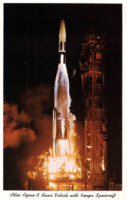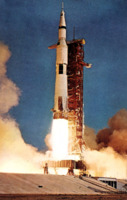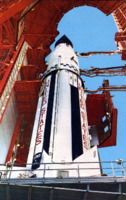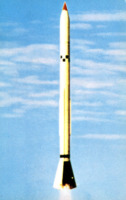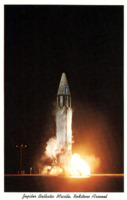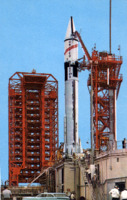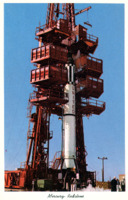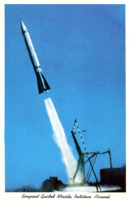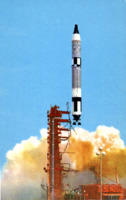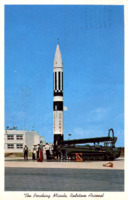
Browse Items (4796 total)
Sort by:
-
Atlas Agena-B Space Vehicle with Range Spacecraft
Front: Atlas Agena-B Space Vehicle with Ranger Spacecraft
Back: ATLAS AGENA-B SPACE VEHICLE WITH RANGER SPACECRAFT
The Atlas Agena-B space vehicle it shown here with its Ranger spacecraft payload on the pad at Cape Canaveral. Fla. The Atlas Agena-B is being used by NASA to launch the 750-pound Ranger lunar impact missions. The Atlas Agena-B program is managed by the NASA Marshall Space Flight Center, Huntsville, Alabama. -
Saturn V Launch
Back: This Is the National Aeronautics and Space Administration's Apollo/Saturn V vehicle, used to place man on the moon. The Saturn V vehicle, developing 7.6 million pounds thrust, was developed under the direction of the NASA-Marshall Space Flight Center, Huntsville, Ala. -
"NASA'S SA-5 undergoing pre-lounch check-out."
Back: NASA'S SA-5 undergoing pre-launch check-out. The Saturn is the free-world's largest space booster. It develops a million and a half pounds thrust. The NASA Marshall Space Flight Center at Huntsville. Alabama, has been developing and providing rockets for our space achievements since the very beginning of our entry into this field. -
Corporal Guided Missile
Back: CORPORAL GUIDED MISSILE REDSTONE ARSENAL, HUNTSVILLE, ALABAMA
A member of the Army missile family used in support of ground combat operations, the Corporal, equipped with either an atomic or conventional type warhead, is a surface-to-surface guided missile capable of engaging tactical targets far beyond the range of conventional artillery. A powerful rocket motor propels the missile through space, at several times the speed of sound. -
Jupiter Ballistic Missile
Front: Jupiter Ballistic Missile, Redstone Arsenal
Back: JUPITER BALLISTIC MISSILE, REDSTONE ARSENAL, HUNTSVILLE, ALABAMA
The largest weapon, for which the Army has development responsibility, the Jupiter has pin-point accuracy against targets at ranges up to 1,500 nautical miles. The missile is 58 feet in length, and 105 inches in diameter. -
Centaur II undergoes pre-launch tests
Back: Centaur II, our first space vehicle to use liquid hydrogen as a propellent, undergoes pre-launch tests.
The NASA Marshall Space Flight Center at Huntsville, Alabama, has been developing and providing rockets for our space achievements since the very beginning of our entry into this field. -
Mercury Redstone
Front: Mercury Redstone
Back: National Aeronautics and Space Administration's "Mercury-Redstone" being readied for launch at the Cape Kennedy launch site. The rocket was provided by the NASA George C. Marshall Space Flight Center, Huntsville, Alabama. -
Sergeant Guided Missile
Front: Sergeant Guided Missile, Redstone Arsenal.
Back: SERGEANT GUIDED MISSILE, REDSTONE ARSENAL, HUNTSVILLE, ALABAMA.
Measuring about 30 feet in length, the Army's Sergeant is a surface-to-surface, solid propellant, ballistic guided missile possessing a very high degree of reliability and accuracy. Also highly mobile, it can be quickly emplaced and fired by a very small crew, under all conditions of weather and terrain, delivering a nuclear blow far behind enomy lines. Its highly accurate guidance system is invulnerable to any known means of enemy counter-measures. -
Gemini - Titan I Lifting Off Launching Pad
Back: Gemini-Titan 1 lifting off launching pad on its maiden voyage, testing spacecraft and vehicle. The Gemini is the first of NASA's two-man spacecrafts. The NASA Marshall Space Flight Center at Huntsville, Alabama, has been developing and providing rockets for our space achievements since the very beginning of our entry into this field. -
The Pershing Missile
Front: The Pershing Missile, Redstone Arsenal
Back: THE PERSHING MISSILE, REDSTONE ARSENAL, HUNTSVILLE, ALABAMA
This Pershing surface to surface missile can deliver an atomic warhead deep into enemy territory. The Army missile is a solid propellant ballistic missile under development by the Army Ballistic Missile Agency to replace the old reliable Redstone. The missile is named for General of the Armies John J. Pershing, World War I hero.
